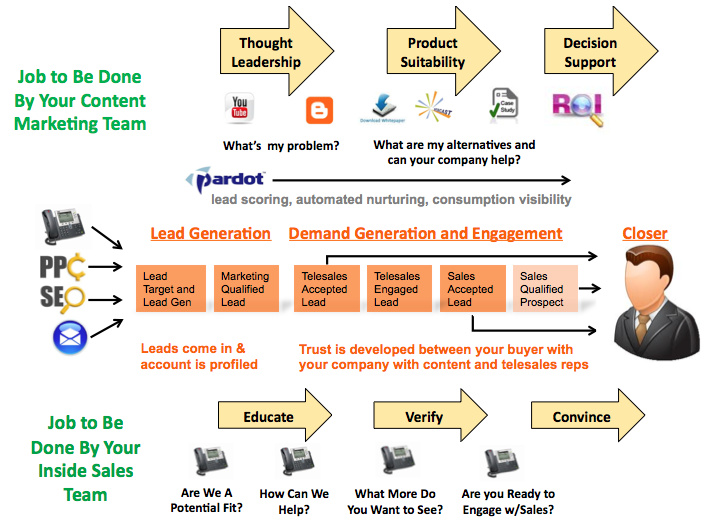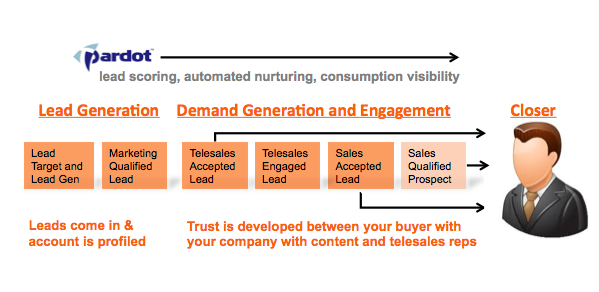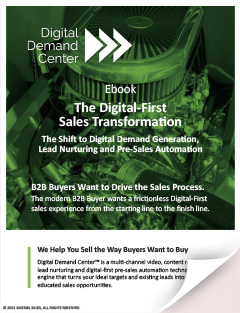This blog is part of a two part series that discusses two marketing automation implementation best practices to accelerate your demand generation engine implementation using Sales Lead Definitions. These marketing automation implementation best practices allow marketers we work with to increase their initial lead volume from our initial Gabriel Sales Ramp™ Campaign (to keep the sales team happy) while we also help to build your engine.
As background – as Gabriel Sales works with our clients building a repeatable telesales process and demand generation engine, we often discover that your company has great metrics and processes to move deals from “Sales Qualified Opportunity” to “Close” but limited visibility into the Early Stage Pipe metrics. Just like late stage pipe velocity, using Sales Lead Definitions to define the discrete stages of your early stage pipe is critical to success of any integrated content marketing and sales effort to put more sales qualified leads into the pipe.
The purpose of this blog is to introduce a marketing automation implementation best practice using Sales Lead Definitions to help accelerate agreement on how the early stage pipe can be scored so your sales team:
- Can quickly help marketing create the lead definitions and get back to selling
- Has the flexibility to successfully take early stage leads from the pipe in the short term to take advantage of the initial lead volume
- And as the engine reaches maturity, the sales team reaps the benefit of more sales qualified leads in the mid and long term
Starting with the End in Mind with your Marketing Automation Implementation
Building a Demand Generation engine does not happen overnight but once created it pays huge dividends. The top three short term benefits are:
- Turn buyers ready to buy into Sales Qualified Leads faster to increase your sales pipeline’s velocity
- Maximize your lead generation budget by effectively nurturing leads not ready to buy so when they are ready to buy they buy from you, (which will eventually increase the size of your sales qualified pipeline)
- Reduce the cost of time spent by your senior sales reps and product specialists educating and selling to buyers that are not ready to engage with sales yet (or buyers who are just kicking the tires and never plan on buying) so your top resources spend their time focused on “closest to the dollar” activities.
Once the engine is built the end goal is to take your increased revenue and the bottom line savings your demand generation engine is producing to:
- Put more even more leads into the pipe
To build an engine requires a telesales team and marketing team aligned with a singular focus of putting more sales qualified leads into the hands of your closers. Below is how this alignment works.

A Framework for Agreement on the Lead Stages is a Critical Marketing Automation Best Practice
Most clients we work with are generally great at defining what a “Lead” is and what a “Sale Qualified Lead” is. If a company has an active inside sales team in place already they may have some of the other sales lead definitions in place as well.
As part of our initial consulting work we work with the sales team to distill specific probing and open ended questions that can be used in the early stage sales process to define where the buyer is in their sales process. This is then used by both marketing and the inside team to support the sales team.
Ultimately the key driver to the organization is going to be how many deals actually close. What a combined telesales and marketing team can impact is how many “Sales Qualified Leads” get in the hands of the “Closer”.
There is no one right and wrong way to set the criteria below. What we are sharing is a starting point so your executives and your closers can evaluate the early stage pipe and make better decisions about what actions to take. For sales specifically it is meant to communicate where the buyer is in their buying cycle, if and when sales should engage and how sales should approach engaging your buyer (where is the buyer in their buying cycle). The criteria below allows your marketing automation to do its job and allows your inside team to move deals through the pipe more effectively. When properly executed you will:
- Save your closers and product specialist’s bandwidth.
- Allow your sales team to “cherry pick” leads from the pipe earlier if they see an opportunity they would like to pursue.
- Clearly communicates to your sales team where the buyer is in their buying cycle so they know how to best approach that buyer.
 Lead Target – The decision makers and companies you are targeting. Ideally you are targeting an ideal customer profile.
Lead Target – The decision makers and companies you are targeting. Ideally you are targeting an ideal customer profile.
Marketing Qualified Lead – Any lead that has expressed mild interest or raised their hand and opted into receiving content from your company. The source of the lead does not matter.
Telesales Accepted Lead – A lead where the company is the right fit (right account profile) and the buyer you are speaking with has the interest in learning more. May have the ability to influence or may have the ability to get you in front of the influencer or decision maker.
Telesales Engaged Lead – (a sub set of Telesales Accepted Lead). There is an agreed next step. Could be in a week, month or could be in a quarter. In some cases it could be at a specific point in time for next year’s budget cycle. Typically the buyer has been asked if they are ready to talk to sales and has declined “not yet but stay in touch”.
Sales Accepted Lead – You know the lead has the ability to influence or champion. Your product can solve a problem the buyer has articulated. May be willing to schedule an appointment. May require someone more senior to move forward.
Sales Qualified Lead – Meets one or more of the following criteria. Decision maker is involved. Path to budget or live budget is in play. A champion has expressed interest in moving the deal forward with you. Specific pain or need has been articulated by the buyer.
We generally find that reaching the initial agreement is simple to reach as part of our initial interview process. Once the questions and criteria are in place we are able to work with our client to keep lead volume up as we work with our clients to build the engine. For more marketing automation implementation best practices details check out our next best practice blog – How to Keep Volume Up as You Build Your Engine.
.




